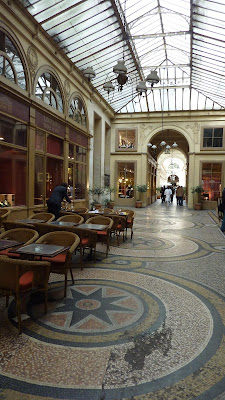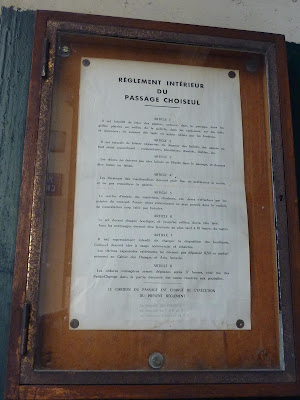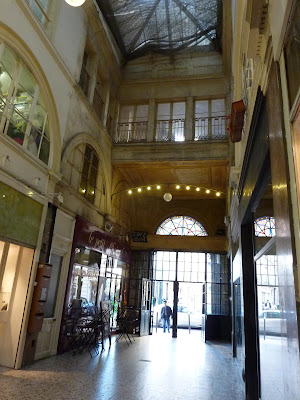crossings ( or tunnels) covered Paris! We will begin a quest to Royal Palace (1st district), and in another time ...
From 1786, the future Philippe Egalite (1747-1793), Duke of Orleans, had built the wooden galleries of the Palais Royal on the periphery of his residence by architect Victor Louis (1731-1800). These 120 shops built around the garden, offering entertainment and luxury goods, are then one of the busiest areas of Paris until the Revolution of 1830 .
Among the first true built passages (passage Feydeau in 1791 was demolished in 1824), passages and panoramas of Cairo, built in 1799) remains the only way panoramas. The passages Delorme and Montesquieu, now extinct, will appear under the Empire. Thirty passages will be built under the Restoration (1814-1830) and the July Monarchy (Louis-Philippe 1st 1830-1848).
Covered by a canopy, the transition is bright.
is a meeting place (sometimes gallantry) and purchases (through trade). It is on the right bank, where the crowd is large between the main boulevards and around the halls.
Louis Sebastien Mercier (1740-1814), writer, playwright, journalist and political writer ("publicist" in the language of the time), evokes in these words in 1808, the reasons for success Galleries: " In a city of luxury and badauderie where he was unpleasant if not dangerous to venture into the Street, the crowd of idlers had to wear to the few places that offered him the opportunity to linger outside shops without fear of crowding or accident .
More a hundred passes are available at Paris under the Second Empire period in which the prefect Haussmann undertook a complete overhaul of the geography of Paris. Most do not resist this change, amplified by the appearance of the first stations and rise of department stores.
Come see some of those who remain ...
Gallery Vero-Dodat, restored in 1997, opens at 19 rue Jean-Jacques Rousseau (75001) ...
a look to the corner shop, No. 36, the studio of designer shoes, ...

and closes (or vice versa) at 2, rue du Bouloi a portal flanked by two Ionic pilasters and surmounted by a balcony railing cast .
Very elegant and comfortable "rigorous" ! Floor, tiles, checkered black and white marble. Fronts, largely glass, combine the dark wood, bronze and brass trimmings which form semicircular arches.
Another time?
In 1826, the gallery is lighted with gas (one of the first places of the capital) and is a tremendous success when it opened.


A crowd outside a shop ... It " Aubert "which prints and sells newspapers" Le Charivari and La Caricature. " The caricatures of Daumier, Gavarni, Ham or Grandville are exposed in the window!
travelers waiting for their diligence, the general Messaging Bouloi installed street, stagecoach terminus France come here to stroll among the trendy shops.
Passage Vero-Dodat occupies the site of the Hotel d'Antoine de Dreux Aubay, poisoned his two son by his daughter, the Marquise de Brinvilliers executed in 1676. It was built (house and route) by Benedict Vero deli - deli rue Montesquieu - who bought the hotel in 1823 with his partner Dodat. An example of real estate speculation of the Restoration
... But ... the creation of the Rue du Louvre in 1854 then the disappearance of Messengers in 1880 (the railways!), will cause a decline in the gallery.
Can we give credit to the antiquary Robert Capi, No. 23-26, a specialist in antique dolls, which says to always apply the rules of procedure established under Charles X: "neither dog nor phonograph, or parrot ... " ?
Back to the Royal Palace rue Montesquieu and the passage Truth (not invented!), A look columns Buren (1986)
before borrowing Galerie de Valois, along the gardens, right, luxury boutiques, somewhat outdated ...
The Galerie Vivienne at No. 4 rue des Petits-Champs (75002). She has two other inputs (or outputs) at No. 5 Street Bank and No. 6 rue Vivienne (75002).
Again this pattern of curved shapes here, bent on the mezzanine floor above the shops ;
the dome skylight and nymphs ;
rounded arches that even these chanted the canopy, square columns and pilasters to light wood ...
Paved mosaic, like a big game of "hopscotch" rounded ground work Facchina "mosaic of the Opera "bathed in light by a elegant and high canopy, it encourages dawdling ...

Especially as it hosts many shops ready-to-wear and decorative items. A tearoom can ask them to enjoy the atmosphere a little outdated so charming . A fragrant floral shop alley with his compositions of "flowers of illusion."
Old houses like the bookstore Siroux Breakfast (1828) found there yet. The writer Colette (1873-1954) came there willingly.
At No. 13 in the gallery, where in 1840 lived Vidocq, the convict became head of a police squad made up of former criminals, is a monumental staircase is quite remarkable.
nymphs and goddesses of the rotunda, caduceus, anchors and cornucopias that adorn the windows in half-moons appear again accustomed to visitors, many income ...
the early 20th century demolition of the gallery is neglected and considered the dome collapsed in 1961 due to work. Kenzo presents his first show in 1970 and the 19th century becomes "common". So in 1974, registered in the Inventory of Historic Monuments, it will finally be restored and regain its animation ... The installation of "Jean-Paul Gaultier" in 1986 dedicated as the key location for Parisian fashion. The artists she has always attracted the tourists and the curious cross stop there ... ... even
In the 1820s, the president of the Chamber of Notaries, Master Marchoux , who lived in this neighborhood business, bought the hotel located at 6 Rue Vivienne and the house next whose garden overlooked the Rue des Petits-Champs. To build the most beautiful and most attractive walkways of Paris, he appealed to the architect Jacques-François Delannoy, trained at the School of the Empire . This association pilasters, arches and cornices, the various symbols of success (laurel wreaths, wheat sheaves and fins), wealth (cornucopia) and Trade (caduceus of Mercury).
The gallery, opened in 1826, benefits from an exceptional location, between the Palais Royal in decline, the stock market and the Grands Boulevards. In 1830, Berlioz tells how, just days after the revolution of July, a crowd filled the Galerie Vivienne and sang the Marseillaise Read it in the Gallery, next door to the JPG ...
Its shops tailor, shoemaker, restaurant (restaurant Grignon), bookseller, mercer, confectioner, attract stamp dealer many onlookers .... until the Second Empire ... the relocation of businesses to the prestigious Madeleine and the Champs-Elysees, it loses some of its attractions ... found today, with great happiness!
Exit 6 rue Vivienne, opposite the Bibliotheque Nationale (Richelieu).
In this same building, is still one of the finest breweries in the capital, the "brewery of the great Colbert, rebuilt exactly in 1983.
Entry 6 rue Vivienne, Galerie Colbert ! No, no mistake!
Since this street a short passage leads to the rotunda ... , impressive!
Alley main, is a seamless pattern, bordered fronts "mirror", is bordered by semicircular arches fully glazed, half punctuated by faux marble columns, and decorated with polychrome motifs, covered with a canopy supported by a series of triangular pediments.
The whole frozen desert and recalls the splendor of antiquity. We must dare cross ! Only fancy, the white globes clustered ...
The National Institute of History of Art now occupies the spot with the National Heritage Institute.
Acquired by the National Library and listed on the Inventory of Historic Monuments in 1974, the gallery has been completely restored (rebuilt ...) in 1985 by architect Adrien Blanchet . To the chagrin of conservatives, this Renovation did not reconstitute the rotunda and the same windows were replaced with modern materials.
History ...
In 1826, the company of speculators Adam & Company bought the state a former hotel, built by Le Vau, who belonged to Colbert, then the regent Philippe d'Orleans , where the Fund for Public Debt had its premises.
To compete with the Galerie Vivienne neighbor, Adam and Co. decided to build, in lieu of the hotel, a shopping just as remarkable as its neighbor. Architect J. Billaud raised a large rotunda, illuminated by a glass dome . In the center he placed a beautiful bronze candelabra bearing a crown of seven globes crystal, illuminated by gas, which was called the "coconut Shining which became a mecca for trysts under the July Monarchy.
The architecture of the gallery inspired throughout Europe: the principle of the rotunda was often successful when it came to cross paths in a gallery.
Since its opening, it was "the most beautiful gallery among the various passages built recently." However, its elegance and modern architecture does not allow him to achieve the success of its rival . Its failure Commercial intensify in 1830, when the Palais Royal will be abandoned by the beautiful world. The gallery will be donated to the Institut de France in 1859 and virtually abandoned until the year 1974 ...
After the release of this gallery rue des Petits-Champs , just keep on this road to the right along the first National Library (Richelieu) to the entry of passage Choiseul, easily identifiable by its glass exterior !
Passage Choiseul , therefore, 40, rue des Petits Champs - 23, rue Saint Augustin, 75002, 6-46, rue Dalayrac,
and 59-61, rue Sainte Anne (by passage Sainte Anne).
is one of the longest Parisian galleries with 190m long.
It has both the bustling boulevards and the excitement of an area mainly frequented by businessmen and bankers his attendance depends hours office, the passage being little used outside these hours. Even if we can find a nice pattern in the architecture, it is sparsely decorated and shops do not have a particularly attractive ornamental.
Take a look at this text ... displayed at the entrance, rue Saint-Augustin .
The place has a literary past;
Alphonse Lemerre's leading publisher poets Parnassiens (Théodore de Banville, Leconte de Lisle ...) there was a publishing house (in activity from 1863 to 1965). He published including "The Contemporary Parnassus" which is manifest and the illustration of the poetic school known Parnassian defending the lyricism and impersonal theory of art for art
Later, Louis Ferdinand Celine child lived for many years, his mother, Marguerite Destouches, including holding a store of "objects of curiosity" at No. 67 then in 1904 at No. 64, she specialized in selling lingerie Luxury, lace and antiques. So read what he said passage of the "Berezina" in 1936 ... in "Death credit "or in" Journey to the End of the Night "?
Theatre Bouffes-Parisiens (4 rue Monsigny) has its secondary output in the passage and contributes to its animation. He took the name of Parisians Bouffes décembre1855 its opening end.
It Offenbach who had then enlarge and beautifully decorated by Theodore Ballu (1817-1885) and who ran for 7 years . This theater was demolished and rebuilt on site enlarged by Theodore Charpentier in 1863.
y Kenzo opens its first store in 1970, Jungle Jap before reaching the Place des Victoires, leaving the passage regain its "quiet" ...
It was built in 1829 near the Grands Boulevards, crowded by architect Antoine Tavernier, succeeding Francis Mazois, location of four adjacent townhouses purchased by the bankers of Mallet brothers and Lemercier Nerville to make a speculative . The promoters did demolish these hotels, with the exception of some elements Hall Gesvres which were preserved, including the porch of the north entrance of the passage.
In 1891, the glass roof is redone, it seems weakened again today ...
Other galleries, there ... it will be for an upcoming trip, other places, same time!
soon!


















































0 comments:
Post a Comment